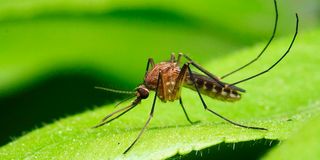‘New’ mosquito species lands in Kisumu

Kemri detected a new dangerous mosquito vector in Kenya on December 22, 2022. It has since been spotted in Kisumu.
Kisumu residents have sounded the alarm over the presence of a unique mosquito species that scientists say can spread two parasites that cause malaria.
They say that lately, they have noticed the newer paler mosquitoes.
"I had never seen these kinds of mosquitoes before. What's unique about them, they cluster in large numbers where there is a source of light at night," said Mrs Mary Otieno.
The Kisumu CEC for medical services and public health, Dr Gregory Ganda, said the Anopheles stephensi mosquito might pose a setback in the fight against malaria.
"This mosquito species can spread both Plasmodium falciparum and Plasmodium vivax malaria parasites,” said Dr Ganda.
A recent Kenya Medical Research Institute (Kemri) report warns that unlike before, now with Anopheles stephensi, there is a likelihood of malaria transmission occurring in urban and peri-urban areas, with the detection of the mosquito species.
Kemri Director-General Sam Kariuki said studies carried out in the country in December 2022 show that the mosquito is moving to areas initially thought to be safe from malaria.
Marsabit too affected
Anopheles stephensi has also be sighted in Laisamis and Saku sub-counties in Marsabit County, northern Kenya.
"Laboratory assays were conducted to confirm the identity of the vector. The new mosquito poses a serious threat and could reverse the gains made in the fight against malaria," said Prof Kariuki.
From the research, the mosquito exhibits different behaviour from the known malaria-transmitting mosquitoes in the country.
"The new mosquito thrives in urban settings, unlike known malaria vectors that are mainly found in rural areas. It mainly breeds in containers such as jerry cans, tyres, open tanks, sewers, cisterns, overhead tanks and underground tanks," he said.
The known malaria mosquitoes in Kenya breed in rural areas in habitats such as water pools, rice paddies, streams, surface run-offs, streams, sprints, tyre tracks and hoof prints.
The new mosquito is invasive and can spread very fast to new areas with or without the known malaria mosquitoes.
Anopheles stephensi can adapt to different climatic and environmental conditions. It was originally known to occur and spread malaria in Southeast Asia, the Middle East and the Arabian Peninsula.
The species has been expanding its geographic range over the last decade, with detections in Djibouti (2012), Ethiopia and Sudan (2016), Somalia (2019) and Nigeria (2020).
Malaria is a leading public health problem in Kenya. The disease is endemic in various parts of the country and almost 70 per cent of the entire population is at risk.
The disease accounts for 13-15 per cent of hospital outpatient visits.
Malaria affects individuals of all ages and is a major cause of morbidity and mortality among pregnant women and children under five years of age.
The disease is transmitted through the infectious bite of the Anopheles female mosquito that carries the parasite.
In Kenya, malaria is spread by two major mosquitoes namely Anopheles gambiae and Anopheles funestus.





